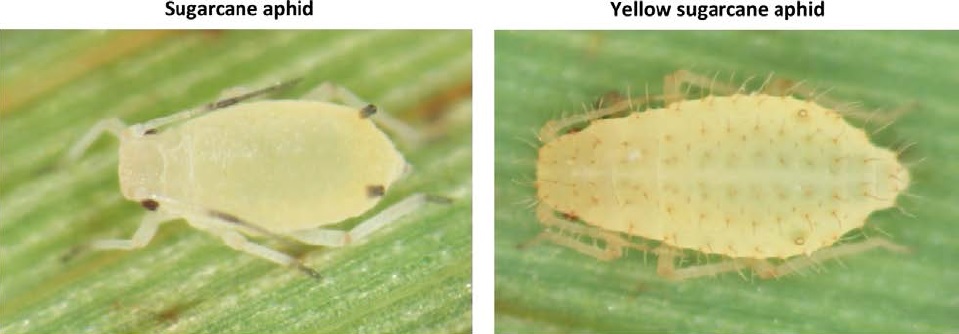
Agricultural News
Damaging Aphids Found in Oklahoma Sorghum Fields
Tue, 29 Jul 2014 19:10:57 CDT

Sorghum growers in Oklahoma should be on the lookout for two types of sugarcane aphids in their fields.
Both the sugarcane aphid and yellow sugarcane aphid are pests of sorghum, and have been viewed in samples taken by the Oklahoma Cooperative Extension Service. Both types of aphids colonize the surfaces of the lower leaves of sorghum, and then move up to newer leaves. Their feeding causes red or brown leaf discoloration on both sides of the leaf.
"Despite their names and common plant hosts, they are different in appearance and differ in how they cause damage to sorghum," said Tom Royer, Oklahoma State University Cooperative Extension entomologist.
Radio Oklahoma Ag Network Farm News Director Ron Hays interviewed Royer about these aphids that came into Oklahoma. Click on the LISTEN Bar at the bottom of this story for Royer's comments.
The sugarcane aphid
Sugarcane aphids are light yellow, with dark, paired "tailpipes" called cornicles and dark "feet" called tarsi. Oklahoma entomologists first noted their state presence in Bryan County in 2013. The pest also has been viewed in southern and eastern Texas, southwestern Louisiana and eastern Mississippi.
"This aphid developed large populations in sorghum, supporting the growth of a black fungus called 'sooty mold' and producing significant amounts of sticky honeydew that coated leaf surfaces and interfered with harvest operations by clogging combines and slowing the movement of material through the machines," Royer said.
The honeydew also interfered with the separation of grain from stalks and leaves so that grain was left on the ground. Texas producers reported up to 50 percent losses in 2013.
"We have had little experience with this aphid and are relying on data and recommendations generated from Texas, Louisiana and Mexico," Royer said. "When populations of sugarcane aphids increase rapidly, insecticides may be needed to prevent yield losses and honeydew buildup before harvest."
Current recommendations are to treat if 30 percent to 40 percent of plants are infested, defined as at least one colony of aphids on a plant.
"We are currently looking to evaluate insecticides for effectiveness in Oklahoma," Royer said.
Texas plot tests conducted in Beaumont and Corpus Christi indicated Dimethoate 4E applied at one pint per acre and Lorsban 4E applied at one quart per acre provided acceptable control. However, other tests conducted in the Lower Rio Grande Valley looking at Lorsban 4E and Dimethoate 4E produced only about 50 percent control.
"It is important to remember Dimethoate has a 28-day pre-harvest interval, and Lorsban at the one quart rate requires a 60-day pre-harvest interval," Royer said. "Tests also showed pyrethroids, such as products containing lambda cyhalothrin, were ineffective."
Oklahoma obtained a Section 18 Emergency Exemption Label for the use of Transform WG that is in effect until Oct. 31, 2014. It has been effective in tests when used at a rate of 0.75 ounce per acre, and is registered for application at 0.75 to 1.5 ounces per acre.
"Dr. David Kerns, LSU Extension entomologist, has told us most applications in Louisiana have been going out at one ounce per acre," Royer said.
The yellow sugarcane aphid
Yellow sugarcane aphids are bright yellow with many hairs on their body and no extended cornicles. They have long been recognized as pests of sorghum and sugarcane in the United States, from southern Texas and Louisiana to Florida. They are occasional pests of sorghum in Oklahoma but do not normally overwinter in the state.
Royer said yellow sugarcane aphids are more of a problem in sorghum seedlings, where even small colonies can kill plants and reduce plant stands. As sorghum grows, the plants typically become more tolerant to the aphids.
"Yellow sugarcane aphids don't often build up into large numbers in maturing sorghum," Royer said. "If they do, greenbug treatment thresholds are recommended as a guideline for their control."
Therefore, control recommendations for yellow sugarcane aphids would be:
- 5-leaf-stage through mid-whorl stage: Visible damage on leaves (red spots/yellow leaves) but before any entire leaves are killed on 20 percent of plants.
- Boot through heading stage: Death of one functional leaf per plant.
- Heading through soft-dough stage: Death of two functional leaves per plant.
"State sorghum producers should consult OSU Current Report CR-7170, Management of Insect and Mite Pests in Sorghum, and look under greenbug control for information about registered insecticides they can use to help control yellow sugarcane aphids," Royer said.
The current report can be accessed at all OSU Cooperative Extension county offices or online by Clicking Here.
WebReadyTM Powered by WireReady® NSI
Top Agricultural News
More Headlines...



















